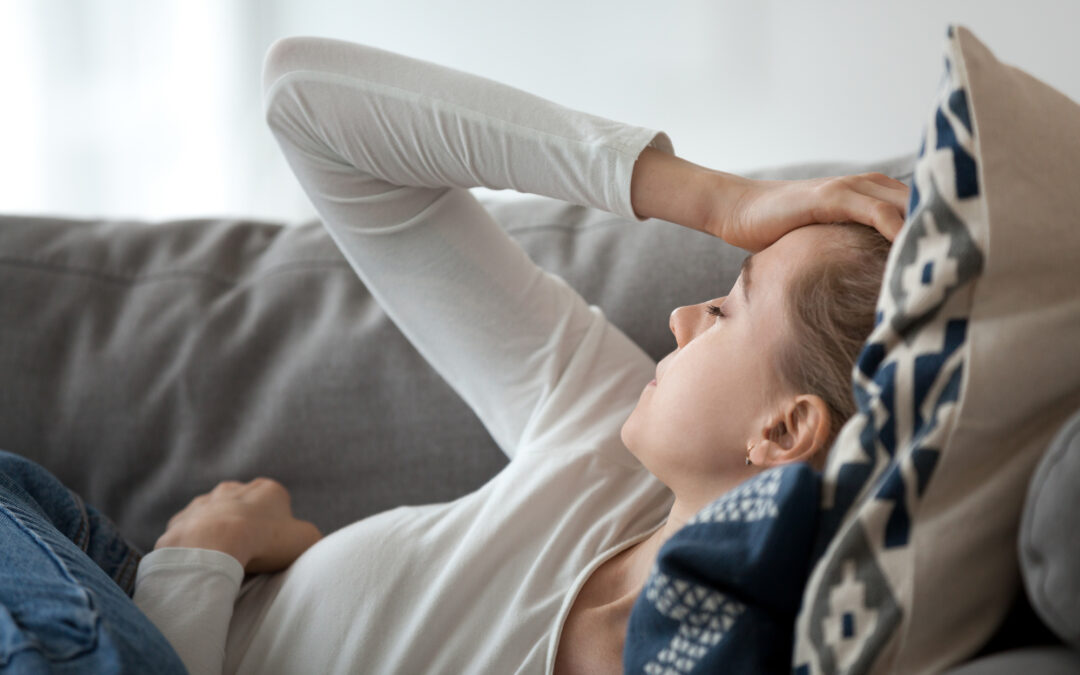The Prevalence of Migraines
Migraines are an extraordinarily common neurological problem, the third most prevalent medical illness in the world, which affects 12% of the population. Almost 40 million men, women, and children suffer from recurring migraines.1 You likely have someone in your family or people you know who suffer from these persistent headaches.
While traditional medical prescriptions can alleviate and mask the pain of a migraine headache, supplemental treatments such as acupuncture can not only alleviate the pain but also reduce the frequency of occurrence, providing a better treatment plan for overall health and wellbeing.
Migraines Versus Headaches
Migraines differ from other types of headaches in severity, frequency, and the fact that oncoming migraines can often be predicted. Migraines are also diagnosed by a physician.
Unlike occasional headaches caused by sinuses, dehydration, caffeine withdrawal, and other causes, migraines occur regularly and have far more intense pain. This pain is often localized to one side of the head and is characterized by extreme throbbing or pulsing that can last from hours to days. These headaches are often accompanied by nausea, vomiting, and extreme sensitivity to light and sound.
What’s interesting about migraines is that they are often precipitated by bodily warnings. The migraine sufferer may be alerted to an oncoming migraine by ocular auras (flashes of light or other visual disturbances), tingling or numbness on one side of the body including the face, or even a sudden difficulty in speaking.
Migraine Stages
Migraines have four stages:
- Prodrome – Typically occurring one or two days before the migraine strikes, there are subtle bodily changes such as constipation, mood changes, food cravings, neck stiffness, increased urination, fluid retention, and frequent yawning. When these warnings occur, they are often so subtle that the migraine sufferer may be unaware they have entered the prodrome stage.
- Aura – This is the visual disturbance phase that can last for up to an hour. It is marked by visual disturbances such as flashes of light, tingling and numbness on one side of the body, and oftentimes difficulty in speaking.
- Attack – This is the phase characterized by pain. The full force of the migraine is felt and this can last anywhere from 4 to 72 hours. The migraine is usually felt on one side of the head with throbbing or pulsing pain. During this time, the migraine sufferer may experience nausea, vomiting, and extreme sensory sensitivity.
- Postdrome – This phase immediately follows the end of the migraine pain. During this phase, the migraine sufferer often feels drained and confused. Conversely, a small percentage of people feel elation.
Limitations in Treatment
Medical experts are still uncertain of the precise cause of migraines but know they are related to nerve endings and neurotransmitter functionality and balance.
Today, there is no course of treatment that can completely eliminate migraines. Western medicine can provide prescription drugs to alleviate the pain when a migraine is in full force. They can also be taken when a migraine sufferer knows that a migraine is about to occur, thereby circumventing the pain before it arrives. And we also know that avoidance of certain triggers can lessen the number of attacks, such as alcohol, caffeine, sensory stimuli, certain medications, certain foods, and food additives. But there are also other stimuli that a migraine sufferer cannot avoid such as barometric weather changes, hormone fluctuations, sleep problems, and several other unavoidable stimuli.
Of these, Dr. Ko of 120 Acupuncture says that the number one cause of migraines is stress, and no changes to or limitations in diet will affect the way your body deals with stress and the migraines it may perpetuate.
The Miracle of Acupuncture
Migraine sufferers have an additional treatment option that has been proven to reduce the frequency and severity of migraines. Regular sessions of whole-body acupuncture treatments reduce migraine frequency by at least 50%.2 For any migraine sufferer, this is a life-changing statistic.
Migraines fully disrupt a person’s normal day-to-day routine even when the migraine is being treated with prescription medication. Even with pain control, the pain can return suddenly with quick head movement or sensory stimuli. The frequency of these migraines can utterly devastate the sufferer’s work situation, lifestyle, and familial and friend relationships. But if the frequency was cut in half, something traditional prescriptions cannot accomplish, this can completely turn the life around for any migraine sufferer.
In fact, having fewer migraines also contributes to the overall happiness of a sufferer, which, in turn, nourishes the body with hormone creation and balance. This might be another factor in why acupuncture helps to reduce the frequency of migraines so successfully.
What Acupuncture Does
Acupuncture is meant to accompany traditional western medicine, and work side-by-side with prescription pain management. While it is important to tell your acupuncturist that you suffer from migraines, the best course of action is to schedule full-body sessions on a regular basis. Your acupuncturist will take additional care to also address your migraines.
With full-body acupuncture, the energy flow “qi” is kept in balance along the meridians of the body. The needles are placed at specific pressure points along the back and neck to keep that qi in balance. This method aids any additional placements on the neck and around the base of the head for migraine treatment.
Dr. Ko says that women are more apt to suffer from migraines than men because stress is the biggest factor involved, and women suffer from severe stress with hormonal changes. Stress has been shown to be related to the liver and gallbladder meridians which has a direct impact on migraines. Dr. Ko treats the liver and gallbladder meridians and works to restore the balance between the upper and lower portions of the body.
Acupuncture also helps those who suffer from different types of headaches, such as sinus headaches. But the meridians are treated differently, which is why it is important to discuss what types of headache you suffer from with your acupuncturist.
It is recommended to plan for 6-10 sessions with your acupuncturist for full migraine treatment but going forward, consider adding acupuncture into your regular routine to keep those migraines at bay. It’s not only going to reduce your migraine frequency, it’s going to provide you with a number of whole-body (physical and mental) benefits! It’s a win-win situation.
Dr. Ko advises migraine sufferers that acupuncture is preventative. Treatment isn’t meant to alleviate a migraine while it is happening. Schedule several sessions to prevent them from occurring.
Make an Appointment
If you suffer from migraines, you have an affordable and proven treatment option available to you! And you don’t need a prescription. Call your local acupuncturist today, schedule an appointment, and look forward to a life with your number of migraines possibly cut in half!
You don’t need to have been diagnosed with migraines by a physician to be treated. Migraines are functional illnesses that cannot be managed by western medicine (only covered up). This is the difference between western medicine and Oriental Medicine.
And if you’re in Los Angeles, call Dr. Ko’s office at 120 Acupuncture at 818-980-7979 or contact us today.
The Best Gift You Can Give a Migraine Sufferer
Chances are high that you know a loved one who suffers from debilitating migraines. Call us or your local acupuncturist to arrange for a consultation and session package for your loved one. It’s the single best thing you can do for someone who suffers from migraines.
1Migraine Research Foundation, 2021, Migraine Facts, Retrieved from https://migraineresearchfoundation.org/
2Michael J. Arnold, MD and Jeanette M. McIntyre, MD, July 1, 2017, Acupuncture for Migraine Prevention, Retrieved from https://www.aafp.org/afp/2017/0701/p23.html







